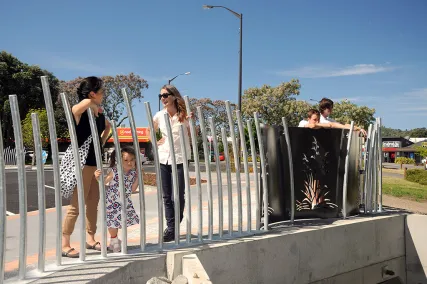 The recently constructed culvert at the western end of The Strand has now had its finishing touches added, in the form of handrails and steel panels inspired by the reeds and harakeke (flax) which once grew in the area.
The recently constructed culvert at the western end of The Strand has now had its finishing touches added, in the form of handrails and steel panels inspired by the reeds and harakeke (flax) which once grew in the area.
The asymmetric, curved handrails are designed to represent reeds and, with the flax cut-out panels on the viewing platforms, are a link to He Matapuna Paru – a historically significant site just to the north of the culvert, which was the source of an intensely black mud used by weavers to dye flax. The original paru source was found by Te Peehi Matekoraha, a Ngāti Awa woman whose weaving was renowned for its intricate patterns and designs. Her skill saw knowledge of the quality of the paru – created by the influences of local flora and natural minerals – spread far afield, and the mud the area produced was much sought after.
The installation of a new and much larger culvert to improve the stormwater flow from the Apanui catchment required the replacement of the previous wooden handrails and allowed a creative solution to be found for a functional requirement.
“The handrails are required for safety reasons, so it came down to a choice between a standard, steel structure, or something a little more imaginative and decorative,” says Whakatāne District Council Infrastructure General Manager, Tomasz Krawczyk. “The cost was virtually the same, so we opted for an artistic interpretation which does the job we want, but captures something of the area’s essence. It also creates a unique and attractive entrance to the CBD.”
The total cost of the culvert replacement, including the handrails and in-house-designed harakeke panels, was $517,000, more than 20 percent less than the project budget of $650,000.
Next month, the drainage channel on both sides of the new culvert – between Pyne Street in the south and the McAlister pump station on the riverbank – will be widened to increase the system’s stormwater detention capacity. This will require the removal of a number of the swamp cypress trees currently growing in the Apanui canal reserve. Once the work has been completed, the reserve will be landscaped and native Kahikatea will be planted.